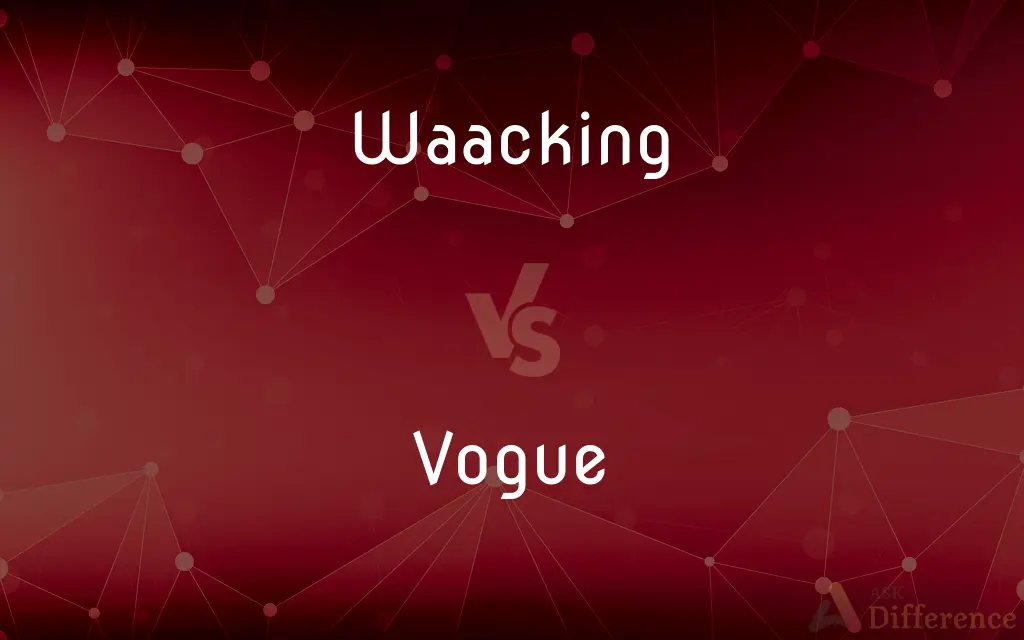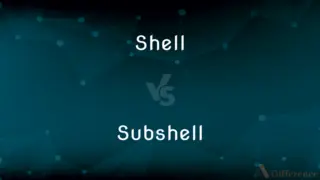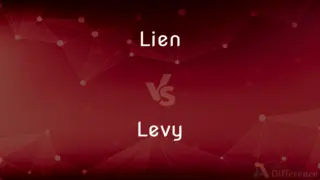Waacking vs. Vogue — What's the Difference?
Edited by Tayyaba Rehman — By Fiza Rafique — Updated on March 13, 2024
Waacking emphasizes arm movements and musicality, while Vogue features model-like poses and catwalk-inspired movements.

Difference Between Waacking and Vogue
Table of Contents
ADVERTISEMENT
Key Differences
Waacking is a dance style that emerged in the LGBTQ+ communities of Los Angeles during the 1970s, known for its flamboyant arm movements and poses, drawing inspiration from movie stars and disco music. On the other hand, Vogueing originated in the late 1980s in New York City, within the same communities, characterized by its striking poses, angular body movements, and elements of the catwalk and ballet.
Waacking involves rapid arm movements, dramatic poses, and a strong emphasis on musicality, allowing dancers to express the music through their bodies. Whereas, Vogueing is divided into different styles such as Old Way, New Way, and Vogue Femme, each with its unique characteristics, but all focus on precision, clean lines, and storytelling through movement.
In Waacking, the use of facial expressions plays a crucial role in conveying emotion and enhancing the performance, making the dance not just about the movements but also about the expression and attitude. On the other hand, Vogueing, especially in its Vogue Femme style, incorporates dramatics and dips (dramatic falls to the ground), adding layers of complexity and theatricality to the dance.
The culture surrounding Waacking includes battles and jams where dancers showcase their skills, improvisation being a key aspect, allowing for personal style and creativity to shine through. In contrast, Vogue balls are a significant aspect of Vogue culture, where dancers compete in various categories, judged on criteria like creativity, execution, and the ability to "sell" their performance to the audience.
Waacking, while having a strong foundation in specific movements and techniques, encourages individual interpretation and the incorporation of other dance styles, making it a highly versatile and personal dance form. Conversely, Vogueing, while also adaptable, maintains strict categories within its culture, each with defined movements and expectations, fostering a sense of community and identity within its practitioners.
ADVERTISEMENT
Comparison Chart
Origin
1970s, Los Angeles
Late 1980s, New York City
Key Elements
Arm movements, poses, musicality
Poses, catwalk, ballet elements
Styles
One main style with personal variations
Old Way, New Way, Vogue Femme
Expression
Emphasis on facial expressions
Use of dramatics and theatricality
Culture
Battles and jams
Vogue balls and categories
Compare with Definitions
Waacking
The use of facial expressions to convey emotion and character in dance.
Her expression while waacking brought the story of the song to life.
Vogue
The theatrical aspects of vogue, including dramatic falls.
The dramatics in his Vogue routine left the audience in awe.
Waacking
The ability to interpret and express music through dance.
His musicality in waacking was unparalleled, perfectly syncing his movements with the beats.
Vogue
A stylized dance form that involves posing, angular movements, and elements of the catwalk.
His vogue performance was mesmerizing, with poses that could rival any model.
Waacking
A dance style characterized by expressive arm movements and poses, inspired by disco and film stars.
She excelled in waacking, capturing the judges' attention with her fluid arm movements.
Vogue
The runway-inspired walk, an essential element in vogue.
Her catwalk during the Vogue performance was as striking as any professional model's.
Waacking
Competitive dance events where waackers showcase their skills.
The waacking battle was intense, with dancers pushing the limits of their creativity.
Vogue
Events where voguers compete in various categories.
The Vogue ball was a dazzling display of talent, with categories ranging from fashion to dance.
Waacking
The spontaneous creation of movements, a key element in waacking.
She wowed the crowd with her improvisation skills in waacking, never missing a beat.
Vogue
Refers to the different forms within vogueing, like Old Way and Vogue Femme.
She specializes in Vogue Femme, known for its fluidity and dramatic dips.
Waacking
Waacking is a form of street dance created in the LGBT clubs of Los Angeles during the 1970s disco era. The style is typically done to 70s disco music and is mainly distinguishable by its rotational arm movements, posing and emphasis on expressiveness.
Vogue
The prevailing fashion, practice, or style
Hoop skirts were once the vogue.
Waacking
A style of disco dance involving rhythmic footwork and moving one's arms to the beat.
Vogue
Popular acceptance or favor; popularity
A party game no longer in vogue.
Vogue
To dance by striking a series of rigid, stylized poses, evocative of fashion models during photograph shoots.
Vogue
The prevailing fashion or style.
Miniskirts were the vogue in the '60s.
Vogue
Popularity or a current craze.
Hula hoops are no longer in vogue.
Vogue
(dance) A highly stylized modern dance that evolved out of the Harlem ballroom scene in the 1960s.
Vogue
(Polari) A cigarette.
Vogue
(intransitive) To dance in the vogue dance style.
Vogue
(Polari) To light a cigarette for (someone).
Vogue me up.
Vogue
The way or fashion of people at any particular time; temporary mode, custom, or practice; popular reception for the time; - used now generally in the phrase in vogue.
One vogue, one vein,One air of thoughts usurps my brain.
Whatsoever its vogue may be, I still flatter myself that the parents of the growing generation will be satisfied with what to be taught to their children in Westminster, in Eton, or in Winchester.
Use may revive the obsoletest words,And banish those that now are most in vogue.
Vogue
Influence; power; sway.
Vogue
The popular taste at a given time;
Leather is the latest vogue
He followed current trends
The 1920s had a style of their own
Vogue
A current state of general acceptance and use
Common Curiosities
How do dancers express themselves in Waacking?
In Waacking, dancers use expressive arm movements, poses, and facial expressions to convey the music and their emotions.
What are the key elements of Vogueing?
Vogueing's key elements include poses, angular movements, and inspiration from the catwalk and ballet.
Where did Waacking originate?
Waacking originated in the LGBTQ+ communities of Los Angeles during the 1970s.
What is the main difference between Waacking and Vogue?
The main difference lies in their key movements; Waacking focuses on arm movements and poses, while Vogue is known for its striking poses and angular body movements.
Can Waacking incorporate other dance styles?
Yes, Waacking encourages individual interpretation and can incorporate elements from other dance styles.
What are Vogue Balls?
Vogue Balls are competitive events where voguers compete in various categories, judged on creativity, execution, and performance.
What is Vogue Femme?
Vogue Femme is a style of Vogueing known for its fluidity, dramatics, and theatrical dips.
Are improvisation skills important in Waacking?
Yes, improvisation is a key aspect of Waacking, allowing dancers to showcase their personal style and creativity.
How do Vogue dancers use the catwalk in their performances?
Vogue dancers incorporate elements of the catwalk into their routines, using poses and walks that mimic runway models.
What role do facial expressions play in Waacking?
Facial expressions in Waacking enhance the performance by conveying emotion and complementing the physical movements.
Is musicality important in both Waacking and Vogue?
Yes, musicality is crucial in both styles, with dancers interpreting and expressing the music through their movements.
What makes Waacking unique compared to other dance styles?
Waacking's uniqueness lies in its emphasis on arm movements, musical interpretation, and the significant role of expression and attitude in performances.
Can anyone learn Waacking or Vogue?
Yes, both dance styles are inclusive and can be learned by anyone willing to practice and embrace their cultures.
How do Vogue Balls contribute to the culture of Vogueing?
Vogue Balls are central to Vogue culture, providing a platform for expression, competition, and community building.
How does Vogueing differ in its styles like Old Way and New Way?
Old Way focuses on clean lines and symmetry, while New Way incorporates more complex, flexible movements; Vogue Femme adds theatricality and dramatics.
Share Your Discovery

Previous Comparison
Shell vs. Subshell
Next Comparison
Lien vs. LevyAuthor Spotlight
Written by
Fiza RafiqueFiza Rafique is a skilled content writer at AskDifference.com, where she meticulously refines and enhances written pieces. Drawing from her vast editorial expertise, Fiza ensures clarity, accuracy, and precision in every article. Passionate about language, she continually seeks to elevate the quality of content for readers worldwide.
Edited by
Tayyaba RehmanTayyaba Rehman is a distinguished writer, currently serving as a primary contributor to askdifference.com. As a researcher in semantics and etymology, Tayyaba's passion for the complexity of languages and their distinctions has found a perfect home on the platform. Tayyaba delves into the intricacies of language, distinguishing between commonly confused words and phrases, thereby providing clarity for readers worldwide.














































